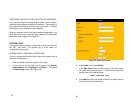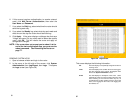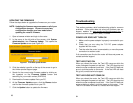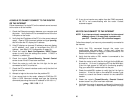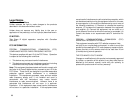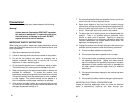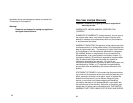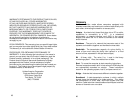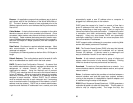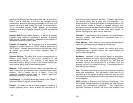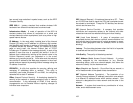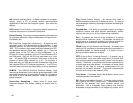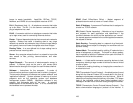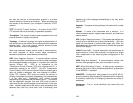99
greater the probability that the original data can be recovered.
Even if one or more bits in the chip are damaged during
transmission, statistical techniques embedded in the radio can
recover the original data without the need for retransmission.
To an unintended receiver, DSSS appears as low power
wideband noise and is rejected (ignored) by most narrowband
receivers.
Dynamic DNS (Domain Name System) – A system for keeping
a domain name linked to a changing IP address. A dynamic
DNS Service Provider maintains a database of the updated IP
addresses linked to a domain name.
Dynamic IP Address - An IP address that is automatically
assigned to a client station in a TCP/IP network, typically by a
DHCP server. Network devices that serve multiple users, such
as servers and printers, are usually assigned static IP
addresses.
Dynamic Routing - The ability for a router to forward data via a
different route based on the current conditions of the
communications circuits. For example, it can adjust for
overloaded traffic or failing lines and is much more flexible than
static routing, which uses a fixed forwarding path.
Ethernet - IEEE standard network protocol that specifies how
data is placed on and retrieved from a common transmission
medium. Has a transfer rate of 10 Mbps. Forms the
underlying transport vehicle used by several upper-level
protocols, including TCP/IP and XNS.
Fast Ethernet - A 100 Mbps technology based on the 10Base-T
Ethernet CSMA/CD network access method.
Firewall – A firewall is a set of related programs, located at a
network gateway server, which protects the resources of a
100
network from users from other networks. (The term also implies
the security policy that is used with the programs.) An
enterprise with an intranet that allows its workers access to the
wider Internet installs a firewall to prevent outsiders from
accessing its own private data resources and for controlling what
outside resources to which its own users have access. A
firewall, working closely with a router, examines
Firmware - Programming that is inserted into programmable
read-only memory, thus becoming a permanent part of a
computing device.
Flash Memory - Flash memory is an electronic storage device
capable of recording several megabytes of data files.
Fragmentation - Breaking a packet into smaller units when
transmitting over a network medium that cannot support the
original size of the packet.
Hardware - Hardware is the physical aspect of computers,
telecommunications, and other information technology devices.
The term arose as a way to distinguish the “box” and the
electronic circuitry and components of a computer from the
program you put in it to make it do things. The program came to
be known as the software.
Hub - The device that serves as the central location for attaching
wires from workstations. Can be passive, where there is no
amplification of the signals; or active, where the hubs are used
like repeaters to provide an extension of the cable that connects
to a workstation.
IEEE (Institute of Electrical and Electronics Engineers) - The
IEEE fosters the development of standards that often become
national and international standards. The organization
publishes a number of journals, has many local chapters, and



